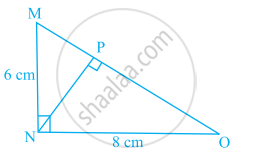Advertisements
Advertisements
Question
Show that ∆ ABC with vertices A (–2, 0), B (0, 2) and C (2, 0) is similar to ∆ DEF with vertices D (–4, 0), F (4, 0) and E (0, 4) ?
Solution
In ΔABC, the coordinates of the vertices are A(–2, 0), B(0, 2), C(2, 0).
\[AB = \sqrt{\left( - 2 - 0 \right)^2 + \left( 0 - 2 \right)^2} =\sqrt{8} = 2\sqrt{2}\]
\[BC = \sqrt{\left( 0 - 2 \right)^2 + \left( 2 - 0 \right)^2} = \sqrt{8} = 2\sqrt{2}\]
\[AC = \sqrt{\left( - 2 - 2 \right)^2 + \left( 0 - 0 \right)^2} = \sqrt{16} = 4\]
In ΔDEF, the coordinates of the vertices are D(–4, 0), E(0, 4) and F(4, 0).
\[EF = \sqrt{\left( 0 - 4 \right)^2 + \left( 4 - 0 \right)^2} = \sqrt{32} = 4\sqrt{2}\]
\[DF = \sqrt{\left( - 4 - 4 \right)^2 + \left( 0 - 0 \right)^2} = \sqrt{64} = 8\]
Thus, ΔABC is similar to ΔDEF.
APPEARS IN
RELATED QUESTIONS
Find the relation between x and y if, the points A(x, y), B(-5, 7) and C(-4, 5) are collinear.
Find the area of the triangle formed by joining the mid-points of the sides of the triangle whose vertices are (0, -1), (2, 1) and (0, 3). Find the ratio of this area to the area of the given triangle
Find the area of the quadrilateral whose vertices, taken in order, are (-4, -2), (-3, -5), (3, -2) and (2, 3).
Find the area of a triangle with vertices at the point given in the following:
(1, 0), (6, 0), (4, 3)
Find the area of a triangle with vertices at the point given in the following:
(−2, −3), (3, 2), (−1, −8)
Find the area of a triangle whose vertices are
`(at_1^2,2at_1),(at_2^2,2at_2)` and `(at_3^2,2at_3)`
Show that the points (-3, -3),(3,3) and C (-3 `sqrt(3) , 3 sqrt(3))` are the vertices of an equilateral triangle.
Find the area of ΔABC with A(1, -4) and midpoints of sides through A being (2, -1) and (0, -1).
If `D((-1)/2, 5/2), E(7, 3)` and `F(7/2, 7/2)` are the midpoints of sides of ∆ABC, find the area of the ∆ABC.
In the given figure, ΔMNO is a right-angled triangle. Its legs are 6 cm and 8 cm long. Length of perpendicular NP on the side MO is ______.

